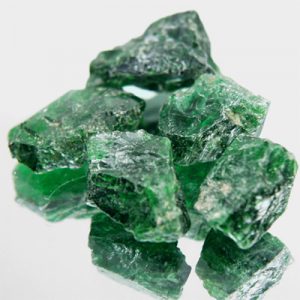Diopside
Diopside is a known member of the Clinopyroxene Subgroup of minerals which includes Aegirine, Diopside, Hedenbergite, Hypersthene, Jadeite, Petedunnite and Spodumene. It is a rock that is essential mineral in some metamorphic and igneous rocks and it is present in meteorites.
Diopside is obtainable in a few varieties and colors from numerous areas, but the deep green, chromium-rich, Chrome Diopside is the absolute most popular and most well known. Chrome Diopside is notably unusual and is mostly available from the Ural Mountains in Russia. Another variety of Diopside is called Violane and is blue, violet or found and purple in Italy. Tashmarine is just a variety of Diopside that is a trade name for the yellowish product that is green found in China. There is also a green “cat’s eye” variety and a really dark “Star Diopside” with a frequently very distinct star that is 4-rayed. Ordinary Diopside is usually pale or white green.
Distribution: Selected localities for fine crystals follow: at Schwarzenstein, Zillertal, and near Prägraten, Tirol, Austria. From Ala, Piedmont, and St. Marcel, Val d’Aosta, Italy. At Outokumpu, Finland. In Russia, during the Akhmatova deposit, near Zlatoust, Ural Mountains; large crystals in the Inagli massif, 30 west that is km of, Yakutia; and across the Slyudyanka River, near Lake Baikal, Siberia. In Canada, many localities; in Ontario, at Bird’s Creek, Eganville, Dog’s Lake, Littlefield, and Burgess; in Quebec, at Wakefield, Brompton Lake, near Magog, and in the Jeffrey mine, Asbestos. In the united states, at DeKalb, St. Lawrence County, Natural Bridge, Jefferson County, Sing Sing, near Ossining, Westchester County, New York; and at Ducktown, Polk County, Tennessee. At Ampandrandava and Andranodambo, Taolanaro (Fort Dauphin), Madagascar. Big crystals that are gemmy the Kunlun Mountains, Sinkiang Uighur Autonomous area, China. From Tange-Achin, Kandahar Province, Afghanistan. Found near Jaipur, Rajasthan, India. At Khapalu and Chamachu, Pakistan.
| Category: | Inosilicate mineral |
| Chemical Formula: | CaMgSi2O6 |
| Calcium Magnesium Silicate | |
| Molecular Weight: | 216.55 gm |
| Composition: | Calcium | 18.51 % | Ca | 25.90 % | CaO |
| Magnesium | 11.22 % | Mg | 18.61 % | MgO | |
| Silicon | 25.94 % | Si | 55.49 % | SiO2 | |
| Oxygen | 44.33 % | O | |||
| 100.00 % | 100.00 % | = TOTAL OXIDE |
| Crystallography: | Monoclinic – Prismatic |
| Crystal Habit: | As prismatic crystals with nearly square cross sections, to 50 cm; granular, columnar, lamellar massive. |
| Twinning: | Simple or multiple twins on {100} or {010} common. |
| Cleavage: | Distinct/Good on {110}; partings on {100} and probably {010} |
| Fracture: | Irregular/Uneven to Conchoidal |
| Tenacity: | Brittle |
| Moh’s Hardness: | 5.5 – 6.5 |
| Density: | 3.22 – 3.38 (g/cm3) |
| Luminescence: | None |
| Radioactivity: | Not Radioactive |
| Color: | Colorless, white, yellow, pale to dark green, black; colorless in thin section. |
| Transparency: | Transparent to Opaque |
| Luster: | Vitreous, Dull |
| Refractive Index: | 1.664 – 1.695 Biaxial ( + ) |
| Birefringence: | 0.024 – 0.031 |
| Dispersion: | Weak to Moderate; r > v |
| Pleochroism: | None |


